[SOLVED] Types and Indicators of Abuse
VerifiedAdded on 2020/10/22
|10
|3346
|246
AI Summary
This report provides a comprehensive overview of types and indicators of abuse in four different case studies. It also explores factors leading to abuse, legislation governing safeguarding, and immediate effects on adult health and well-being. Furthermore, it discusses working strategies and potential long-term effects of abuse. Additionally, it highlights the importance of supportive relationships and multi-agency working to reduce the risk of abuse among adults.
Contribute Materials
Your contribution can guide someone’s learning journey. Share your
documents today.
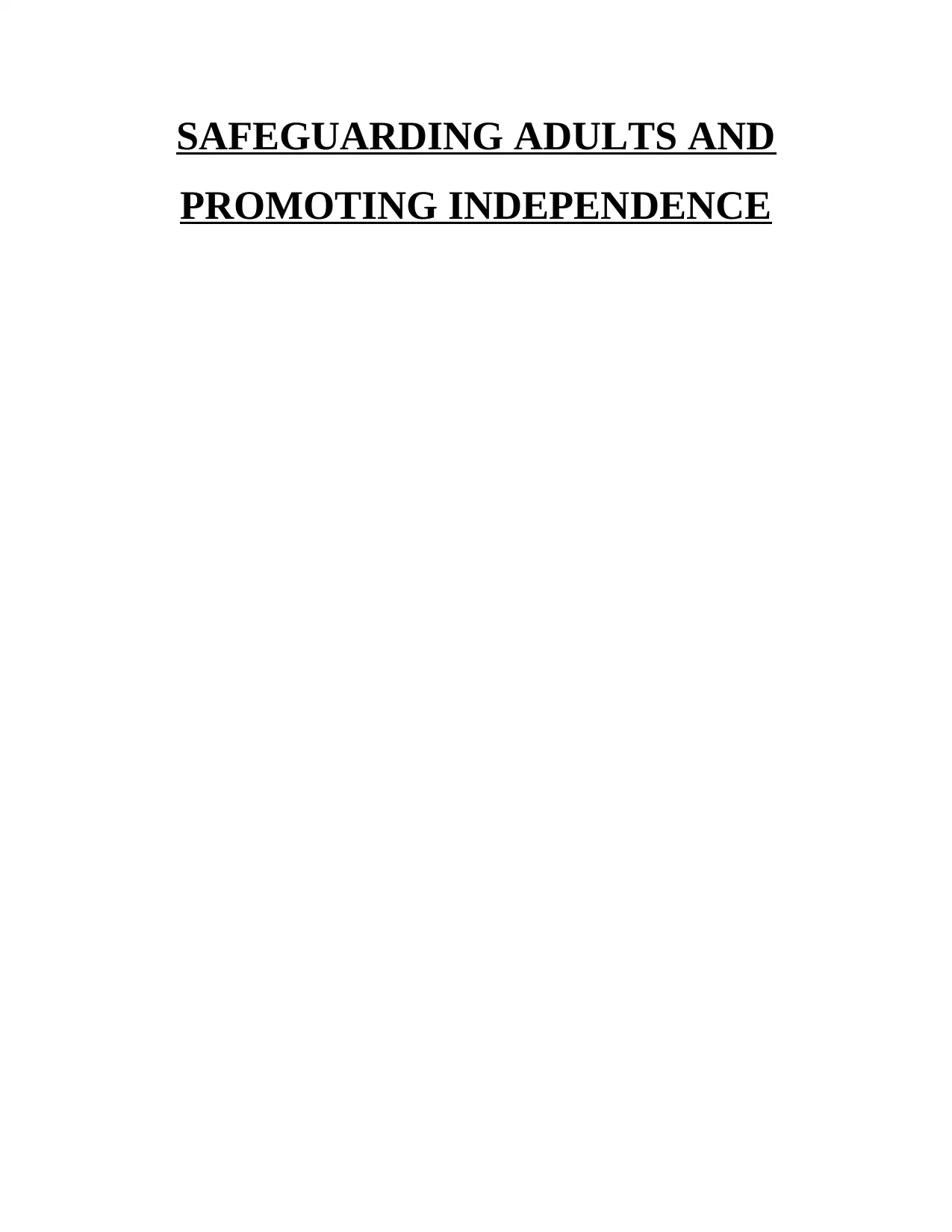
SAFEGUARDING ADULTS AND
PROMOTING INDEPENDENCE
PROMOTING INDEPENDENCE
Secure Best Marks with AI Grader
Need help grading? Try our AI Grader for instant feedback on your assignments.
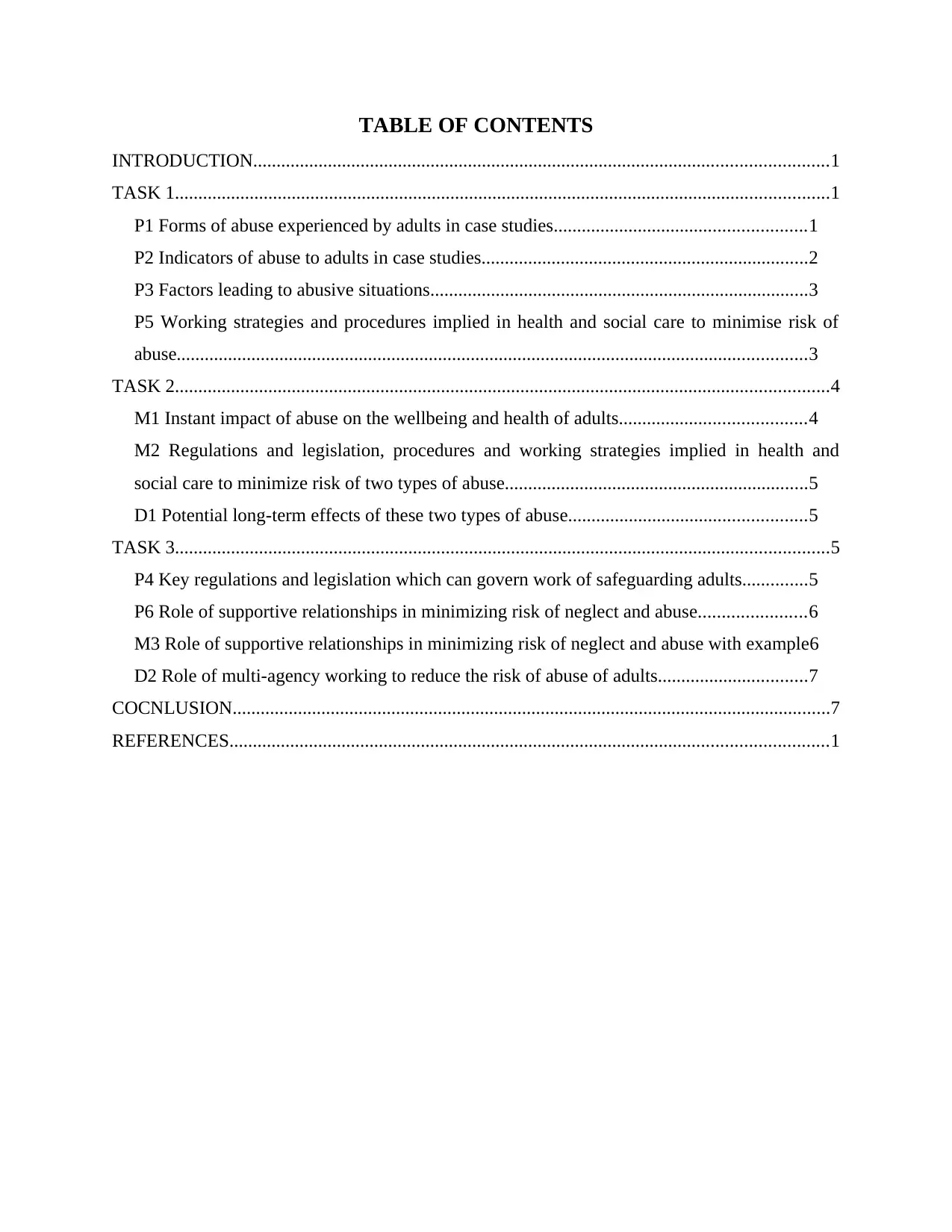
TABLE OF CONTENTS
INTRODUCTION...........................................................................................................................1
TASK 1............................................................................................................................................1
P1 Forms of abuse experienced by adults in case studies......................................................1
P2 Indicators of abuse to adults in case studies......................................................................2
P3 Factors leading to abusive situations.................................................................................3
P5 Working strategies and procedures implied in health and social care to minimise risk of
abuse.......................................................................................................................................3
TASK 2............................................................................................................................................4
M1 Instant impact of abuse on the wellbeing and health of adults........................................4
M2 Regulations and legislation, procedures and working strategies implied in health and
social care to minimize risk of two types of abuse.................................................................5
D1 Potential long-term effects of these two types of abuse...................................................5
TASK 3............................................................................................................................................5
P4 Key regulations and legislation which can govern work of safeguarding adults..............5
P6 Role of supportive relationships in minimizing risk of neglect and abuse.......................6
M3 Role of supportive relationships in minimizing risk of neglect and abuse with example6
D2 Role of multi-agency working to reduce the risk of abuse of adults................................7
COCNLUSION................................................................................................................................7
REFERENCES................................................................................................................................1
INTRODUCTION...........................................................................................................................1
TASK 1............................................................................................................................................1
P1 Forms of abuse experienced by adults in case studies......................................................1
P2 Indicators of abuse to adults in case studies......................................................................2
P3 Factors leading to abusive situations.................................................................................3
P5 Working strategies and procedures implied in health and social care to minimise risk of
abuse.......................................................................................................................................3
TASK 2............................................................................................................................................4
M1 Instant impact of abuse on the wellbeing and health of adults........................................4
M2 Regulations and legislation, procedures and working strategies implied in health and
social care to minimize risk of two types of abuse.................................................................5
D1 Potential long-term effects of these two types of abuse...................................................5
TASK 3............................................................................................................................................5
P4 Key regulations and legislation which can govern work of safeguarding adults..............5
P6 Role of supportive relationships in minimizing risk of neglect and abuse.......................6
M3 Role of supportive relationships in minimizing risk of neglect and abuse with example6
D2 Role of multi-agency working to reduce the risk of abuse of adults................................7
COCNLUSION................................................................................................................................7
REFERENCES................................................................................................................................1
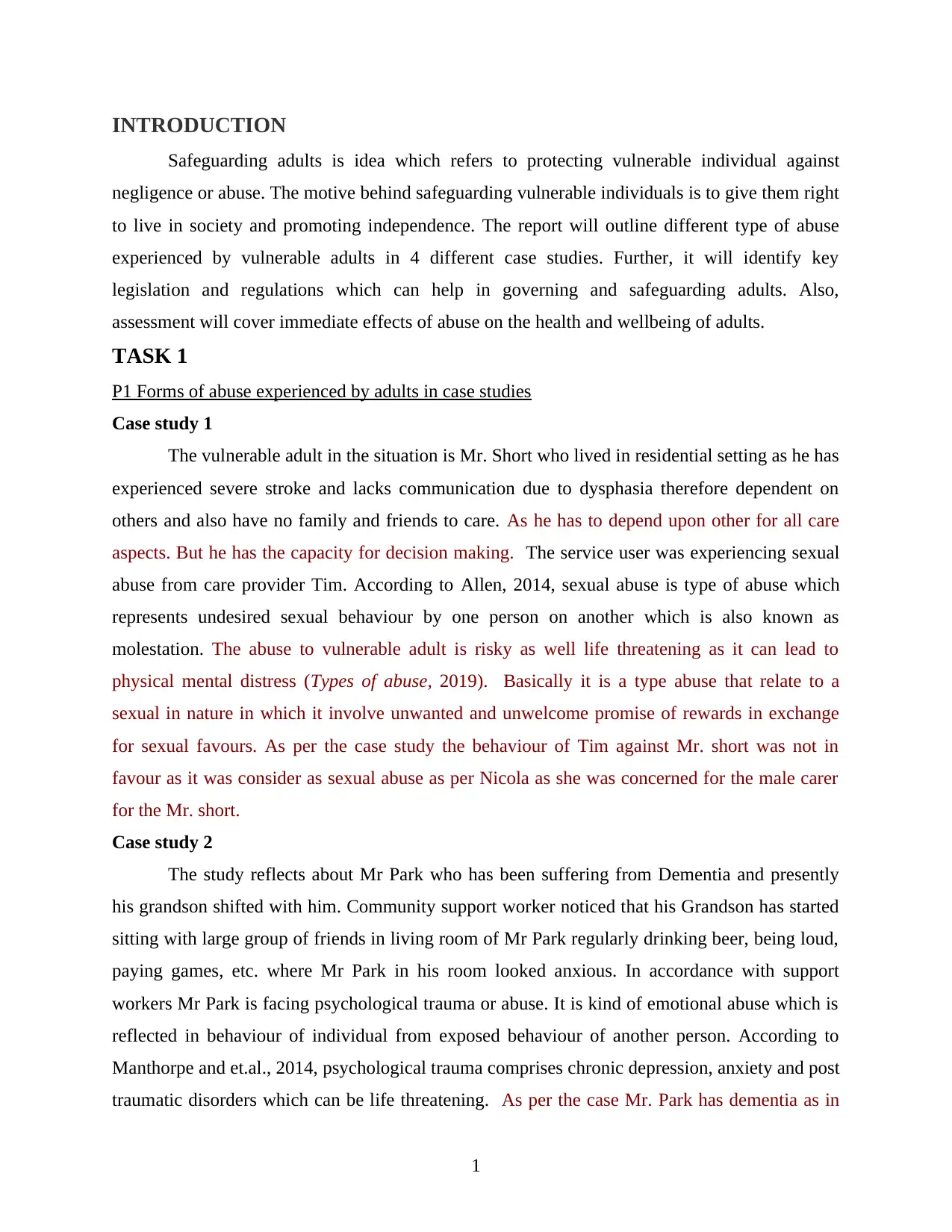
INTRODUCTION
Safeguarding adults is idea which refers to protecting vulnerable individual against
negligence or abuse. The motive behind safeguarding vulnerable individuals is to give them right
to live in society and promoting independence. The report will outline different type of abuse
experienced by vulnerable adults in 4 different case studies. Further, it will identify key
legislation and regulations which can help in governing and safeguarding adults. Also,
assessment will cover immediate effects of abuse on the health and wellbeing of adults.
TASK 1
P1 Forms of abuse experienced by adults in case studies
Case study 1
The vulnerable adult in the situation is Mr. Short who lived in residential setting as he has
experienced severe stroke and lacks communication due to dysphasia therefore dependent on
others and also have no family and friends to care. As he has to depend upon other for all care
aspects. But he has the capacity for decision making. The service user was experiencing sexual
abuse from care provider Tim. According to Allen, 2014, sexual abuse is type of abuse which
represents undesired sexual behaviour by one person on another which is also known as
molestation. The abuse to vulnerable adult is risky as well life threatening as it can lead to
physical mental distress (Types of abuse, 2019). Basically it is a type abuse that relate to a
sexual in nature in which it involve unwanted and unwelcome promise of rewards in exchange
for sexual favours. As per the case study the behaviour of Tim against Mr. short was not in
favour as it was consider as sexual abuse as per Nicola as she was concerned for the male carer
for the Mr. short.
Case study 2
The study reflects about Mr Park who has been suffering from Dementia and presently
his grandson shifted with him. Community support worker noticed that his Grandson has started
sitting with large group of friends in living room of Mr Park regularly drinking beer, being loud,
paying games, etc. where Mr Park in his room looked anxious. In accordance with support
workers Mr Park is facing psychological trauma or abuse. It is kind of emotional abuse which is
reflected in behaviour of individual from exposed behaviour of another person. According to
Manthorpe and et.al., 2014, psychological trauma comprises chronic depression, anxiety and post
traumatic disorders which can be life threatening. As per the case Mr. Park has dementia as in
1
Safeguarding adults is idea which refers to protecting vulnerable individual against
negligence or abuse. The motive behind safeguarding vulnerable individuals is to give them right
to live in society and promoting independence. The report will outline different type of abuse
experienced by vulnerable adults in 4 different case studies. Further, it will identify key
legislation and regulations which can help in governing and safeguarding adults. Also,
assessment will cover immediate effects of abuse on the health and wellbeing of adults.
TASK 1
P1 Forms of abuse experienced by adults in case studies
Case study 1
The vulnerable adult in the situation is Mr. Short who lived in residential setting as he has
experienced severe stroke and lacks communication due to dysphasia therefore dependent on
others and also have no family and friends to care. As he has to depend upon other for all care
aspects. But he has the capacity for decision making. The service user was experiencing sexual
abuse from care provider Tim. According to Allen, 2014, sexual abuse is type of abuse which
represents undesired sexual behaviour by one person on another which is also known as
molestation. The abuse to vulnerable adult is risky as well life threatening as it can lead to
physical mental distress (Types of abuse, 2019). Basically it is a type abuse that relate to a
sexual in nature in which it involve unwanted and unwelcome promise of rewards in exchange
for sexual favours. As per the case study the behaviour of Tim against Mr. short was not in
favour as it was consider as sexual abuse as per Nicola as she was concerned for the male carer
for the Mr. short.
Case study 2
The study reflects about Mr Park who has been suffering from Dementia and presently
his grandson shifted with him. Community support worker noticed that his Grandson has started
sitting with large group of friends in living room of Mr Park regularly drinking beer, being loud,
paying games, etc. where Mr Park in his room looked anxious. In accordance with support
workers Mr Park is facing psychological trauma or abuse. It is kind of emotional abuse which is
reflected in behaviour of individual from exposed behaviour of another person. According to
Manthorpe and et.al., 2014, psychological trauma comprises chronic depression, anxiety and post
traumatic disorders which can be life threatening. As per the case Mr. Park has dementia as in
1
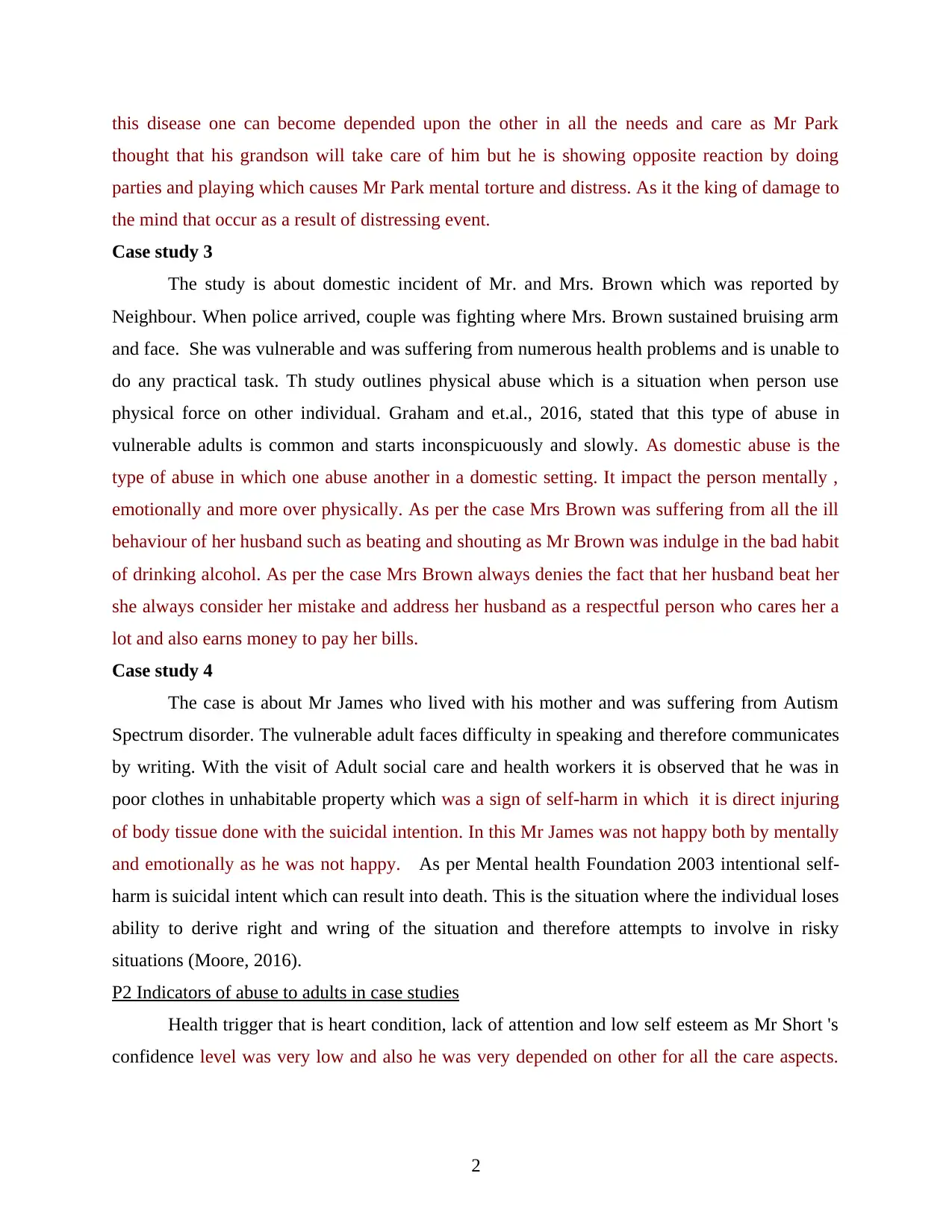
this disease one can become depended upon the other in all the needs and care as Mr Park
thought that his grandson will take care of him but he is showing opposite reaction by doing
parties and playing which causes Mr Park mental torture and distress. As it the king of damage to
the mind that occur as a result of distressing event.
Case study 3
The study is about domestic incident of Mr. and Mrs. Brown which was reported by
Neighbour. When police arrived, couple was fighting where Mrs. Brown sustained bruising arm
and face. She was vulnerable and was suffering from numerous health problems and is unable to
do any practical task. Th study outlines physical abuse which is a situation when person use
physical force on other individual. Graham and et.al., 2016, stated that this type of abuse in
vulnerable adults is common and starts inconspicuously and slowly. As domestic abuse is the
type of abuse in which one abuse another in a domestic setting. It impact the person mentally ,
emotionally and more over physically. As per the case Mrs Brown was suffering from all the ill
behaviour of her husband such as beating and shouting as Mr Brown was indulge in the bad habit
of drinking alcohol. As per the case Mrs Brown always denies the fact that her husband beat her
she always consider her mistake and address her husband as a respectful person who cares her a
lot and also earns money to pay her bills.
Case study 4
The case is about Mr James who lived with his mother and was suffering from Autism
Spectrum disorder. The vulnerable adult faces difficulty in speaking and therefore communicates
by writing. With the visit of Adult social care and health workers it is observed that he was in
poor clothes in unhabitable property which was a sign of self-harm in which it is direct injuring
of body tissue done with the suicidal intention. In this Mr James was not happy both by mentally
and emotionally as he was not happy. As per Mental health Foundation 2003 intentional self-
harm is suicidal intent which can result into death. This is the situation where the individual loses
ability to derive right and wring of the situation and therefore attempts to involve in risky
situations (Moore, 2016).
P2 Indicators of abuse to adults in case studies
Health trigger that is heart condition, lack of attention and low self esteem as Mr Short 's
confidence level was very low and also he was very depended on other for all the care aspects.
2
thought that his grandson will take care of him but he is showing opposite reaction by doing
parties and playing which causes Mr Park mental torture and distress. As it the king of damage to
the mind that occur as a result of distressing event.
Case study 3
The study is about domestic incident of Mr. and Mrs. Brown which was reported by
Neighbour. When police arrived, couple was fighting where Mrs. Brown sustained bruising arm
and face. She was vulnerable and was suffering from numerous health problems and is unable to
do any practical task. Th study outlines physical abuse which is a situation when person use
physical force on other individual. Graham and et.al., 2016, stated that this type of abuse in
vulnerable adults is common and starts inconspicuously and slowly. As domestic abuse is the
type of abuse in which one abuse another in a domestic setting. It impact the person mentally ,
emotionally and more over physically. As per the case Mrs Brown was suffering from all the ill
behaviour of her husband such as beating and shouting as Mr Brown was indulge in the bad habit
of drinking alcohol. As per the case Mrs Brown always denies the fact that her husband beat her
she always consider her mistake and address her husband as a respectful person who cares her a
lot and also earns money to pay her bills.
Case study 4
The case is about Mr James who lived with his mother and was suffering from Autism
Spectrum disorder. The vulnerable adult faces difficulty in speaking and therefore communicates
by writing. With the visit of Adult social care and health workers it is observed that he was in
poor clothes in unhabitable property which was a sign of self-harm in which it is direct injuring
of body tissue done with the suicidal intention. In this Mr James was not happy both by mentally
and emotionally as he was not happy. As per Mental health Foundation 2003 intentional self-
harm is suicidal intent which can result into death. This is the situation where the individual loses
ability to derive right and wring of the situation and therefore attempts to involve in risky
situations (Moore, 2016).
P2 Indicators of abuse to adults in case studies
Health trigger that is heart condition, lack of attention and low self esteem as Mr Short 's
confidence level was very low and also he was very depended on other for all the care aspects.
2
Secure Best Marks with AI Grader
Need help grading? Try our AI Grader for instant feedback on your assignments.
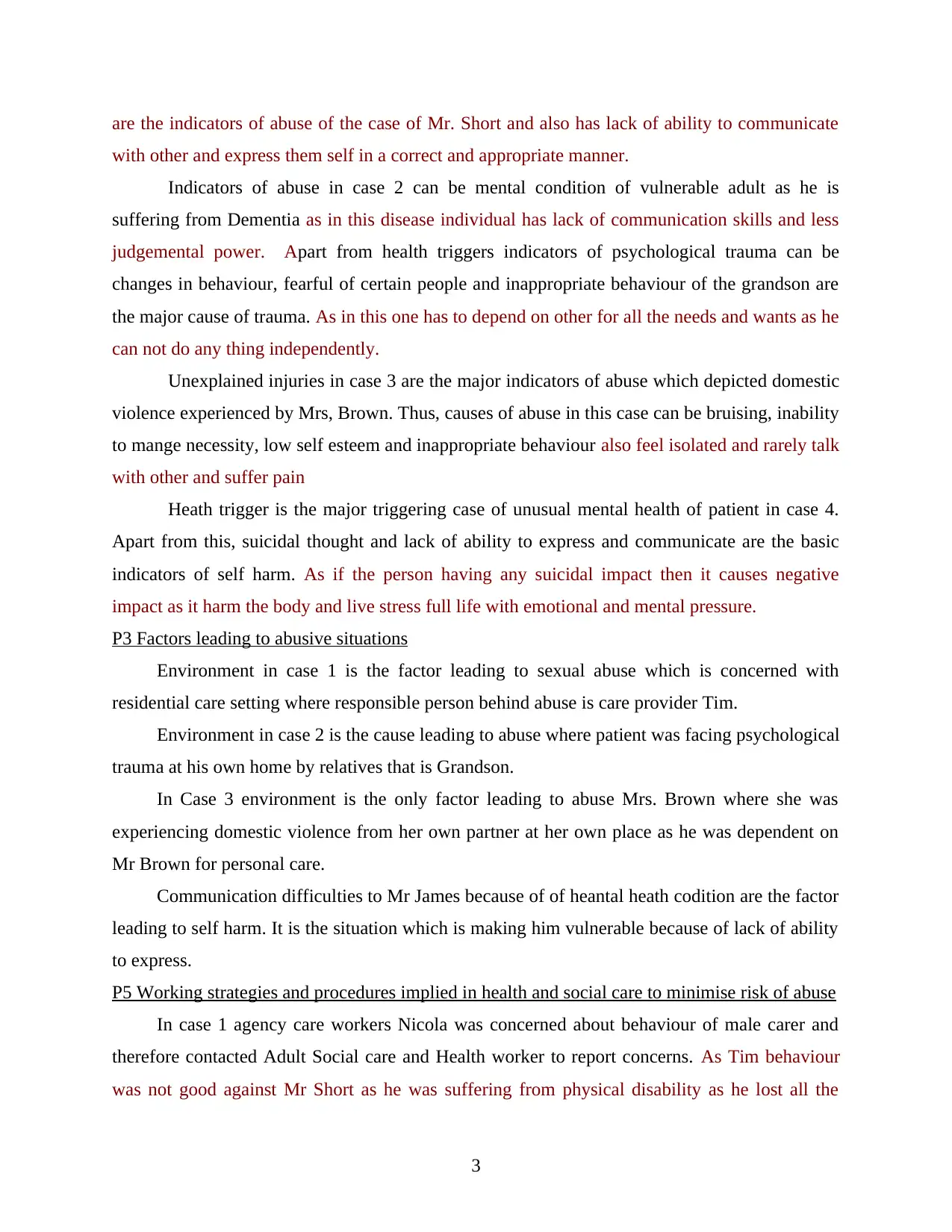
are the indicators of abuse of the case of Mr. Short and also has lack of ability to communicate
with other and express them self in a correct and appropriate manner.
Indicators of abuse in case 2 can be mental condition of vulnerable adult as he is
suffering from Dementia as in this disease individual has lack of communication skills and less
judgemental power. Apart from health triggers indicators of psychological trauma can be
changes in behaviour, fearful of certain people and inappropriate behaviour of the grandson are
the major cause of trauma. As in this one has to depend on other for all the needs and wants as he
can not do any thing independently.
Unexplained injuries in case 3 are the major indicators of abuse which depicted domestic
violence experienced by Mrs, Brown. Thus, causes of abuse in this case can be bruising, inability
to mange necessity, low self esteem and inappropriate behaviour also feel isolated and rarely talk
with other and suffer pain
Heath trigger is the major triggering case of unusual mental health of patient in case 4.
Apart from this, suicidal thought and lack of ability to express and communicate are the basic
indicators of self harm. As if the person having any suicidal impact then it causes negative
impact as it harm the body and live stress full life with emotional and mental pressure.
P3 Factors leading to abusive situations
Environment in case 1 is the factor leading to sexual abuse which is concerned with
residential care setting where responsible person behind abuse is care provider Tim.
Environment in case 2 is the cause leading to abuse where patient was facing psychological
trauma at his own home by relatives that is Grandson.
In Case 3 environment is the only factor leading to abuse Mrs. Brown where she was
experiencing domestic violence from her own partner at her own place as he was dependent on
Mr Brown for personal care.
Communication difficulties to Mr James because of of heantal heath codition are the factor
leading to self harm. It is the situation which is making him vulnerable because of lack of ability
to express.
P5 Working strategies and procedures implied in health and social care to minimise risk of abuse
In case 1 agency care workers Nicola was concerned about behaviour of male carer and
therefore contacted Adult Social care and Health worker to report concerns. As Tim behaviour
was not good against Mr Short as he was suffering from physical disability as he lost all the
3
with other and express them self in a correct and appropriate manner.
Indicators of abuse in case 2 can be mental condition of vulnerable adult as he is
suffering from Dementia as in this disease individual has lack of communication skills and less
judgemental power. Apart from health triggers indicators of psychological trauma can be
changes in behaviour, fearful of certain people and inappropriate behaviour of the grandson are
the major cause of trauma. As in this one has to depend on other for all the needs and wants as he
can not do any thing independently.
Unexplained injuries in case 3 are the major indicators of abuse which depicted domestic
violence experienced by Mrs, Brown. Thus, causes of abuse in this case can be bruising, inability
to mange necessity, low self esteem and inappropriate behaviour also feel isolated and rarely talk
with other and suffer pain
Heath trigger is the major triggering case of unusual mental health of patient in case 4.
Apart from this, suicidal thought and lack of ability to express and communicate are the basic
indicators of self harm. As if the person having any suicidal impact then it causes negative
impact as it harm the body and live stress full life with emotional and mental pressure.
P3 Factors leading to abusive situations
Environment in case 1 is the factor leading to sexual abuse which is concerned with
residential care setting where responsible person behind abuse is care provider Tim.
Environment in case 2 is the cause leading to abuse where patient was facing psychological
trauma at his own home by relatives that is Grandson.
In Case 3 environment is the only factor leading to abuse Mrs. Brown where she was
experiencing domestic violence from her own partner at her own place as he was dependent on
Mr Brown for personal care.
Communication difficulties to Mr James because of of heantal heath codition are the factor
leading to self harm. It is the situation which is making him vulnerable because of lack of ability
to express.
P5 Working strategies and procedures implied in health and social care to minimise risk of abuse
In case 1 agency care workers Nicola was concerned about behaviour of male carer and
therefore contacted Adult Social care and Health worker to report concerns. As Tim behaviour
was not good against Mr Short as he was suffering from physical disability as he lost all the
3
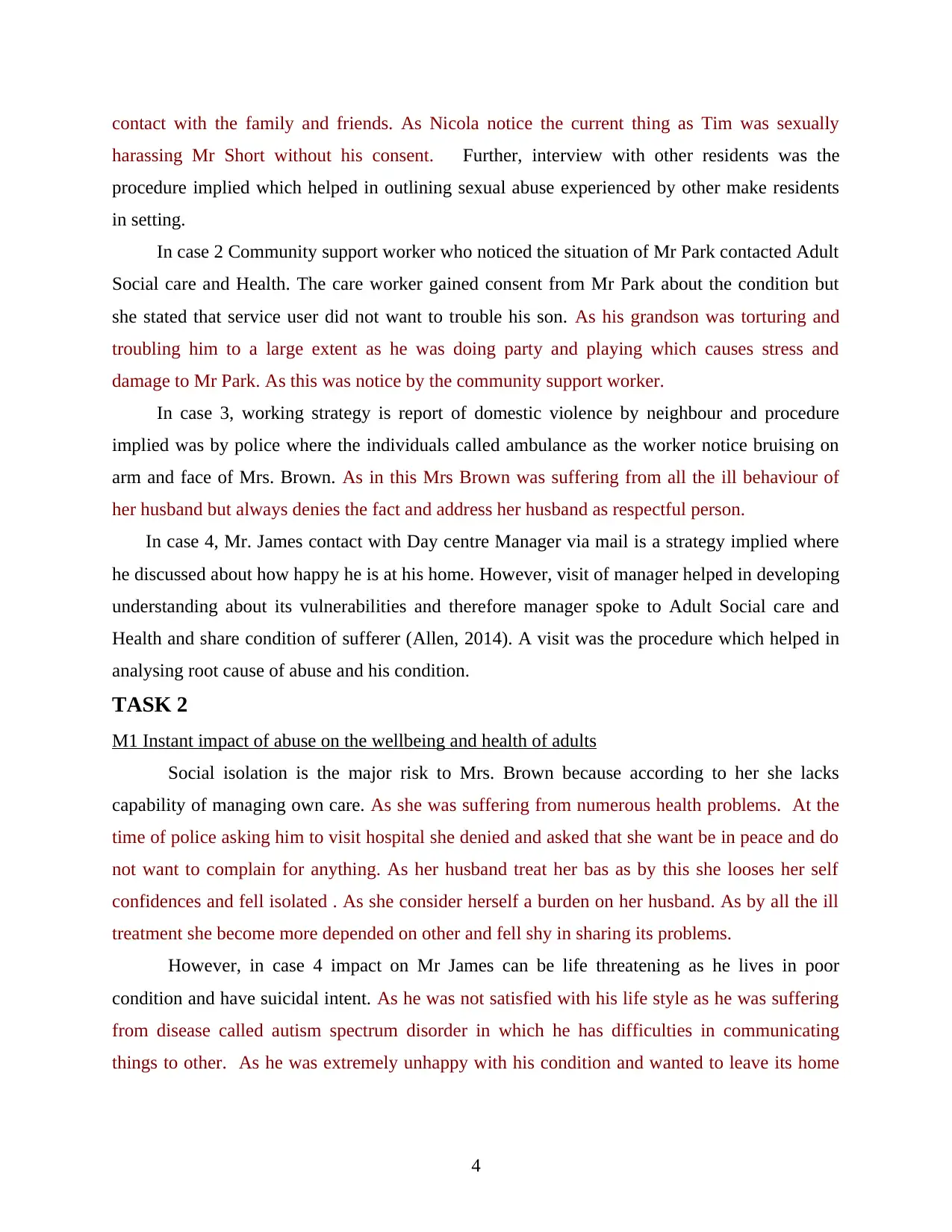
contact with the family and friends. As Nicola notice the current thing as Tim was sexually
harassing Mr Short without his consent. Further, interview with other residents was the
procedure implied which helped in outlining sexual abuse experienced by other make residents
in setting.
In case 2 Community support worker who noticed the situation of Mr Park contacted Adult
Social care and Health. The care worker gained consent from Mr Park about the condition but
she stated that service user did not want to trouble his son. As his grandson was torturing and
troubling him to a large extent as he was doing party and playing which causes stress and
damage to Mr Park. As this was notice by the community support worker.
In case 3, working strategy is report of domestic violence by neighbour and procedure
implied was by police where the individuals called ambulance as the worker notice bruising on
arm and face of Mrs. Brown. As in this Mrs Brown was suffering from all the ill behaviour of
her husband but always denies the fact and address her husband as respectful person.
In case 4, Mr. James contact with Day centre Manager via mail is a strategy implied where
he discussed about how happy he is at his home. However, visit of manager helped in developing
understanding about its vulnerabilities and therefore manager spoke to Adult Social care and
Health and share condition of sufferer (Allen, 2014). A visit was the procedure which helped in
analysing root cause of abuse and his condition.
TASK 2
M1 Instant impact of abuse on the wellbeing and health of adults
Social isolation is the major risk to Mrs. Brown because according to her she lacks
capability of managing own care. As she was suffering from numerous health problems. At the
time of police asking him to visit hospital she denied and asked that she want be in peace and do
not want to complain for anything. As her husband treat her bas as by this she looses her self
confidences and fell isolated . As she consider herself a burden on her husband. As by all the ill
treatment she become more depended on other and fell shy in sharing its problems.
However, in case 4 impact on Mr James can be life threatening as he lives in poor
condition and have suicidal intent. As he was not satisfied with his life style as he was suffering
from disease called autism spectrum disorder in which he has difficulties in communicating
things to other. As he was extremely unhappy with his condition and wanted to leave its home
4
harassing Mr Short without his consent. Further, interview with other residents was the
procedure implied which helped in outlining sexual abuse experienced by other make residents
in setting.
In case 2 Community support worker who noticed the situation of Mr Park contacted Adult
Social care and Health. The care worker gained consent from Mr Park about the condition but
she stated that service user did not want to trouble his son. As his grandson was torturing and
troubling him to a large extent as he was doing party and playing which causes stress and
damage to Mr Park. As this was notice by the community support worker.
In case 3, working strategy is report of domestic violence by neighbour and procedure
implied was by police where the individuals called ambulance as the worker notice bruising on
arm and face of Mrs. Brown. As in this Mrs Brown was suffering from all the ill behaviour of
her husband but always denies the fact and address her husband as respectful person.
In case 4, Mr. James contact with Day centre Manager via mail is a strategy implied where
he discussed about how happy he is at his home. However, visit of manager helped in developing
understanding about its vulnerabilities and therefore manager spoke to Adult Social care and
Health and share condition of sufferer (Allen, 2014). A visit was the procedure which helped in
analysing root cause of abuse and his condition.
TASK 2
M1 Instant impact of abuse on the wellbeing and health of adults
Social isolation is the major risk to Mrs. Brown because according to her she lacks
capability of managing own care. As she was suffering from numerous health problems. At the
time of police asking him to visit hospital she denied and asked that she want be in peace and do
not want to complain for anything. As her husband treat her bas as by this she looses her self
confidences and fell isolated . As she consider herself a burden on her husband. As by all the ill
treatment she become more depended on other and fell shy in sharing its problems.
However, in case 4 impact on Mr James can be life threatening as he lives in poor
condition and have suicidal intent. As he was not satisfied with his life style as he was suffering
from disease called autism spectrum disorder in which he has difficulties in communicating
things to other. As he was extremely unhappy with his condition and wanted to leave its home
4
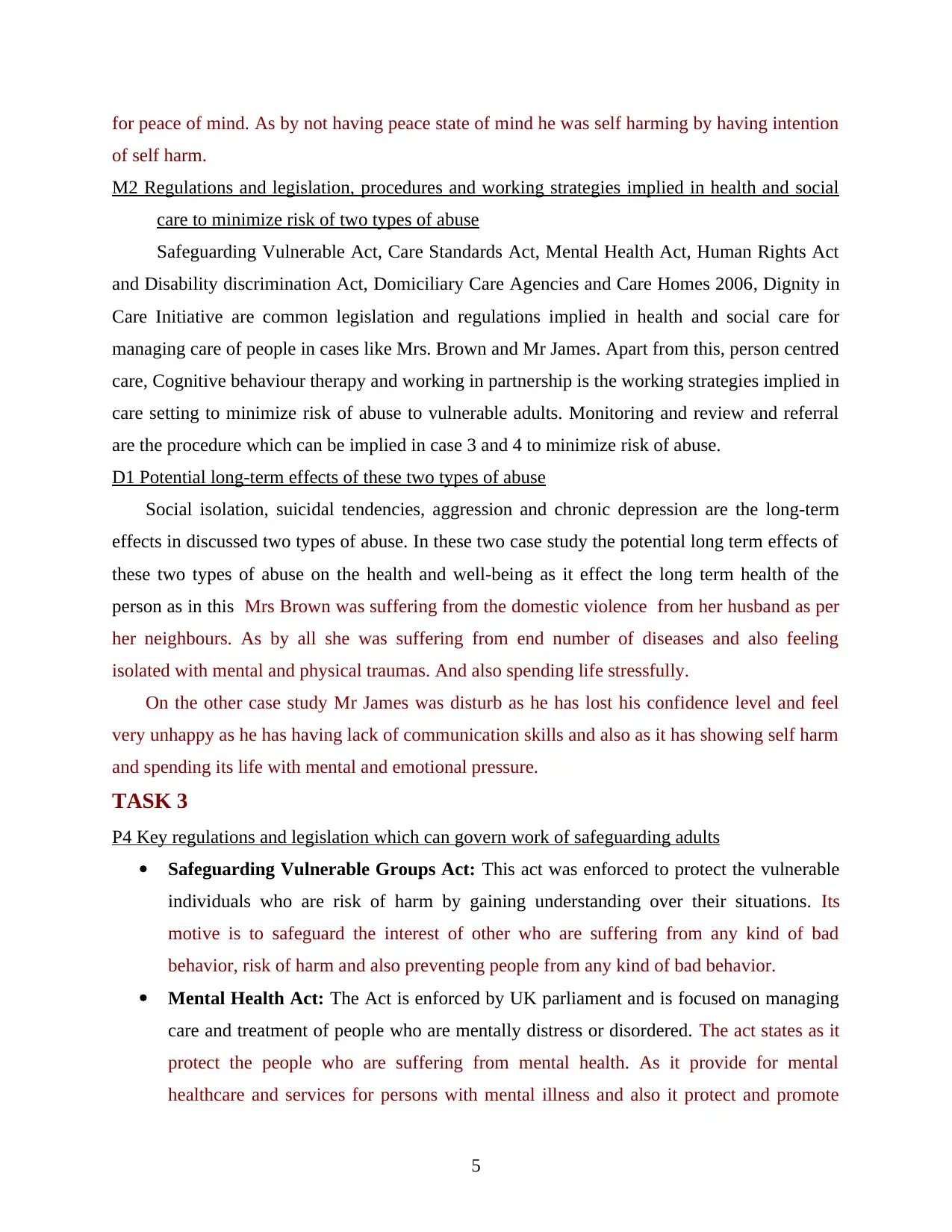
for peace of mind. As by not having peace state of mind he was self harming by having intention
of self harm.
M2 Regulations and legislation, procedures and working strategies implied in health and social
care to minimize risk of two types of abuse
Safeguarding Vulnerable Act, Care Standards Act, Mental Health Act, Human Rights Act
and Disability discrimination Act, Domiciliary Care Agencies and Care Homes 2006, Dignity in
Care Initiative are common legislation and regulations implied in health and social care for
managing care of people in cases like Mrs. Brown and Mr James. Apart from this, person centred
care, Cognitive behaviour therapy and working in partnership is the working strategies implied in
care setting to minimize risk of abuse to vulnerable adults. Monitoring and review and referral
are the procedure which can be implied in case 3 and 4 to minimize risk of abuse.
D1 Potential long-term effects of these two types of abuse
Social isolation, suicidal tendencies, aggression and chronic depression are the long-term
effects in discussed two types of abuse. In these two case study the potential long term effects of
these two types of abuse on the health and well-being as it effect the long term health of the
person as in this Mrs Brown was suffering from the domestic violence from her husband as per
her neighbours. As by all she was suffering from end number of diseases and also feeling
isolated with mental and physical traumas. And also spending life stressfully.
On the other case study Mr James was disturb as he has lost his confidence level and feel
very unhappy as he has having lack of communication skills and also as it has showing self harm
and spending its life with mental and emotional pressure.
TASK 3
P4 Key regulations and legislation which can govern work of safeguarding adults
Safeguarding Vulnerable Groups Act: This act was enforced to protect the vulnerable
individuals who are risk of harm by gaining understanding over their situations. Its
motive is to safeguard the interest of other who are suffering from any kind of bad
behavior, risk of harm and also preventing people from any kind of bad behavior.
Mental Health Act: The Act is enforced by UK parliament and is focused on managing
care and treatment of people who are mentally distress or disordered. The act states as it
protect the people who are suffering from mental health. As it provide for mental
healthcare and services for persons with mental illness and also it protect and promote
5
of self harm.
M2 Regulations and legislation, procedures and working strategies implied in health and social
care to minimize risk of two types of abuse
Safeguarding Vulnerable Act, Care Standards Act, Mental Health Act, Human Rights Act
and Disability discrimination Act, Domiciliary Care Agencies and Care Homes 2006, Dignity in
Care Initiative are common legislation and regulations implied in health and social care for
managing care of people in cases like Mrs. Brown and Mr James. Apart from this, person centred
care, Cognitive behaviour therapy and working in partnership is the working strategies implied in
care setting to minimize risk of abuse to vulnerable adults. Monitoring and review and referral
are the procedure which can be implied in case 3 and 4 to minimize risk of abuse.
D1 Potential long-term effects of these two types of abuse
Social isolation, suicidal tendencies, aggression and chronic depression are the long-term
effects in discussed two types of abuse. In these two case study the potential long term effects of
these two types of abuse on the health and well-being as it effect the long term health of the
person as in this Mrs Brown was suffering from the domestic violence from her husband as per
her neighbours. As by all she was suffering from end number of diseases and also feeling
isolated with mental and physical traumas. And also spending life stressfully.
On the other case study Mr James was disturb as he has lost his confidence level and feel
very unhappy as he has having lack of communication skills and also as it has showing self harm
and spending its life with mental and emotional pressure.
TASK 3
P4 Key regulations and legislation which can govern work of safeguarding adults
Safeguarding Vulnerable Groups Act: This act was enforced to protect the vulnerable
individuals who are risk of harm by gaining understanding over their situations. Its
motive is to safeguard the interest of other who are suffering from any kind of bad
behavior, risk of harm and also preventing people from any kind of bad behavior.
Mental Health Act: The Act is enforced by UK parliament and is focused on managing
care and treatment of people who are mentally distress or disordered. The act states as it
protect the people who are suffering from mental health. As it provide for mental
healthcare and services for persons with mental illness and also it protect and promote
5
Paraphrase This Document
Need a fresh take? Get an instant paraphrase of this document with our AI Paraphraser
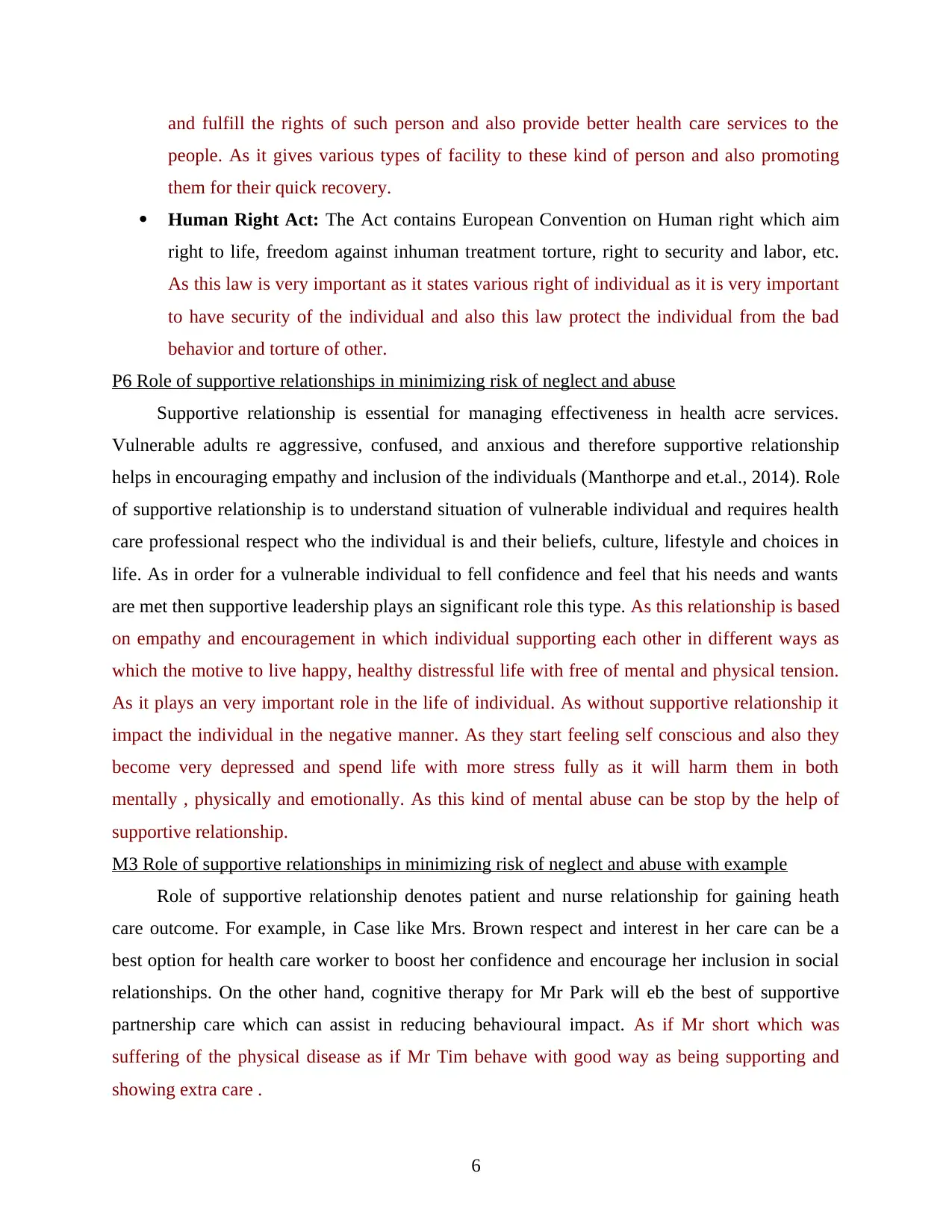
and fulfill the rights of such person and also provide better health care services to the
people. As it gives various types of facility to these kind of person and also promoting
them for their quick recovery.
Human Right Act: The Act contains European Convention on Human right which aim
right to life, freedom against inhuman treatment torture, right to security and labor, etc.
As this law is very important as it states various right of individual as it is very important
to have security of the individual and also this law protect the individual from the bad
behavior and torture of other.
P6 Role of supportive relationships in minimizing risk of neglect and abuse
Supportive relationship is essential for managing effectiveness in health acre services.
Vulnerable adults re aggressive, confused, and anxious and therefore supportive relationship
helps in encouraging empathy and inclusion of the individuals (Manthorpe and et.al., 2014). Role
of supportive relationship is to understand situation of vulnerable individual and requires health
care professional respect who the individual is and their beliefs, culture, lifestyle and choices in
life. As in order for a vulnerable individual to fell confidence and feel that his needs and wants
are met then supportive leadership plays an significant role this type. As this relationship is based
on empathy and encouragement in which individual supporting each other in different ways as
which the motive to live happy, healthy distressful life with free of mental and physical tension.
As it plays an very important role in the life of individual. As without supportive relationship it
impact the individual in the negative manner. As they start feeling self conscious and also they
become very depressed and spend life with more stress fully as it will harm them in both
mentally , physically and emotionally. As this kind of mental abuse can be stop by the help of
supportive relationship.
M3 Role of supportive relationships in minimizing risk of neglect and abuse with example
Role of supportive relationship denotes patient and nurse relationship for gaining heath
care outcome. For example, in Case like Mrs. Brown respect and interest in her care can be a
best option for health care worker to boost her confidence and encourage her inclusion in social
relationships. On the other hand, cognitive therapy for Mr Park will eb the best of supportive
partnership care which can assist in reducing behavioural impact. As if Mr short which was
suffering of the physical disease as if Mr Tim behave with good way as being supporting and
showing extra care .
6
people. As it gives various types of facility to these kind of person and also promoting
them for their quick recovery.
Human Right Act: The Act contains European Convention on Human right which aim
right to life, freedom against inhuman treatment torture, right to security and labor, etc.
As this law is very important as it states various right of individual as it is very important
to have security of the individual and also this law protect the individual from the bad
behavior and torture of other.
P6 Role of supportive relationships in minimizing risk of neglect and abuse
Supportive relationship is essential for managing effectiveness in health acre services.
Vulnerable adults re aggressive, confused, and anxious and therefore supportive relationship
helps in encouraging empathy and inclusion of the individuals (Manthorpe and et.al., 2014). Role
of supportive relationship is to understand situation of vulnerable individual and requires health
care professional respect who the individual is and their beliefs, culture, lifestyle and choices in
life. As in order for a vulnerable individual to fell confidence and feel that his needs and wants
are met then supportive leadership plays an significant role this type. As this relationship is based
on empathy and encouragement in which individual supporting each other in different ways as
which the motive to live happy, healthy distressful life with free of mental and physical tension.
As it plays an very important role in the life of individual. As without supportive relationship it
impact the individual in the negative manner. As they start feeling self conscious and also they
become very depressed and spend life with more stress fully as it will harm them in both
mentally , physically and emotionally. As this kind of mental abuse can be stop by the help of
supportive relationship.
M3 Role of supportive relationships in minimizing risk of neglect and abuse with example
Role of supportive relationship denotes patient and nurse relationship for gaining heath
care outcome. For example, in Case like Mrs. Brown respect and interest in her care can be a
best option for health care worker to boost her confidence and encourage her inclusion in social
relationships. On the other hand, cognitive therapy for Mr Park will eb the best of supportive
partnership care which can assist in reducing behavioural impact. As if Mr short which was
suffering of the physical disease as if Mr Tim behave with good way as being supporting and
showing extra care .
6
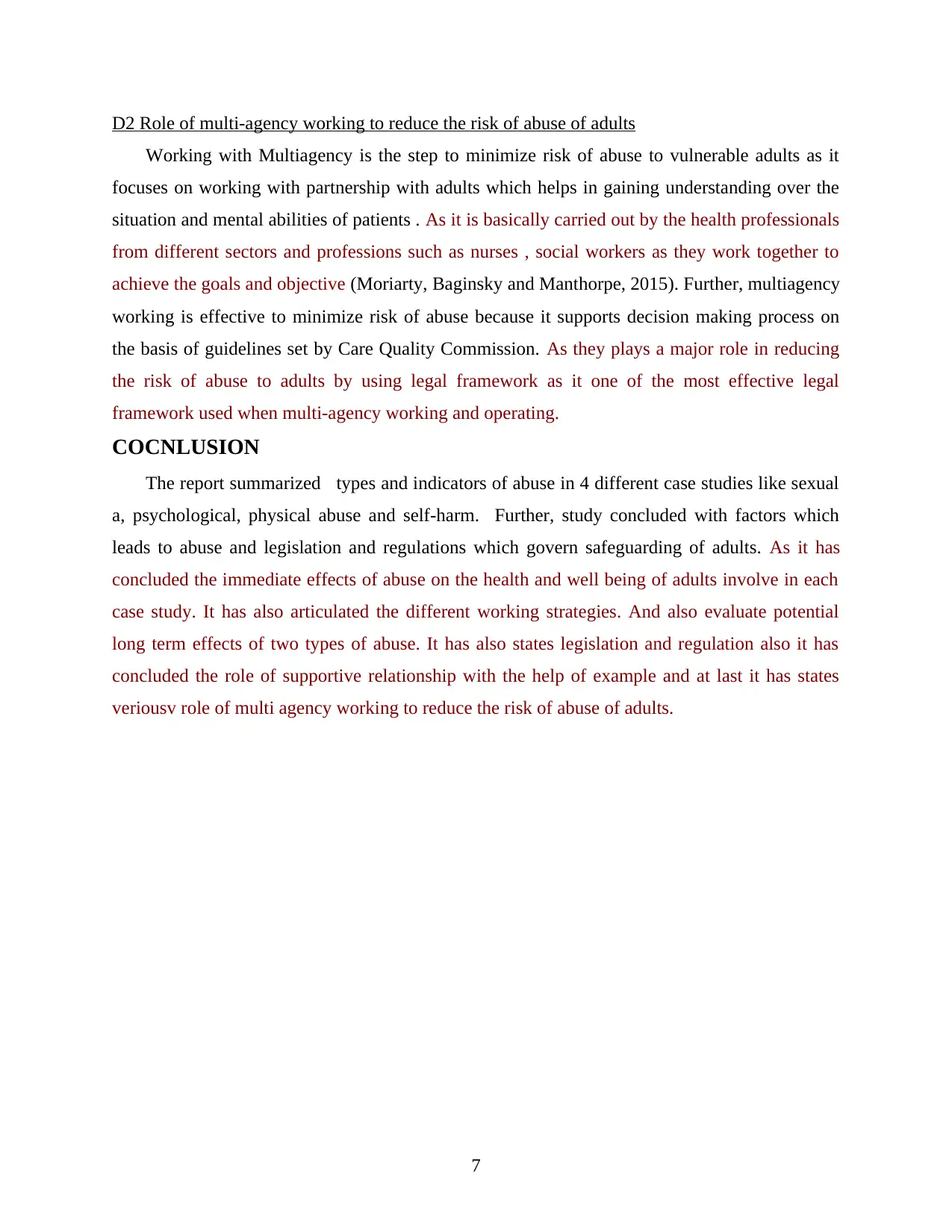
D2 Role of multi-agency working to reduce the risk of abuse of adults
Working with Multiagency is the step to minimize risk of abuse to vulnerable adults as it
focuses on working with partnership with adults which helps in gaining understanding over the
situation and mental abilities of patients . As it is basically carried out by the health professionals
from different sectors and professions such as nurses , social workers as they work together to
achieve the goals and objective (Moriarty, Baginsky and Manthorpe, 2015). Further, multiagency
working is effective to minimize risk of abuse because it supports decision making process on
the basis of guidelines set by Care Quality Commission. As they plays a major role in reducing
the risk of abuse to adults by using legal framework as it one of the most effective legal
framework used when multi-agency working and operating.
COCNLUSION
The report summarized types and indicators of abuse in 4 different case studies like sexual
a, psychological, physical abuse and self-harm. Further, study concluded with factors which
leads to abuse and legislation and regulations which govern safeguarding of adults. As it has
concluded the immediate effects of abuse on the health and well being of adults involve in each
case study. It has also articulated the different working strategies. And also evaluate potential
long term effects of two types of abuse. It has also states legislation and regulation also it has
concluded the role of supportive relationship with the help of example and at last it has states
veriousv role of multi agency working to reduce the risk of abuse of adults.
7
Working with Multiagency is the step to minimize risk of abuse to vulnerable adults as it
focuses on working with partnership with adults which helps in gaining understanding over the
situation and mental abilities of patients . As it is basically carried out by the health professionals
from different sectors and professions such as nurses , social workers as they work together to
achieve the goals and objective (Moriarty, Baginsky and Manthorpe, 2015). Further, multiagency
working is effective to minimize risk of abuse because it supports decision making process on
the basis of guidelines set by Care Quality Commission. As they plays a major role in reducing
the risk of abuse to adults by using legal framework as it one of the most effective legal
framework used when multi-agency working and operating.
COCNLUSION
The report summarized types and indicators of abuse in 4 different case studies like sexual
a, psychological, physical abuse and self-harm. Further, study concluded with factors which
leads to abuse and legislation and regulations which govern safeguarding of adults. As it has
concluded the immediate effects of abuse on the health and well being of adults involve in each
case study. It has also articulated the different working strategies. And also evaluate potential
long term effects of two types of abuse. It has also states legislation and regulation also it has
concluded the role of supportive relationship with the help of example and at last it has states
veriousv role of multi agency working to reduce the risk of abuse of adults.
7
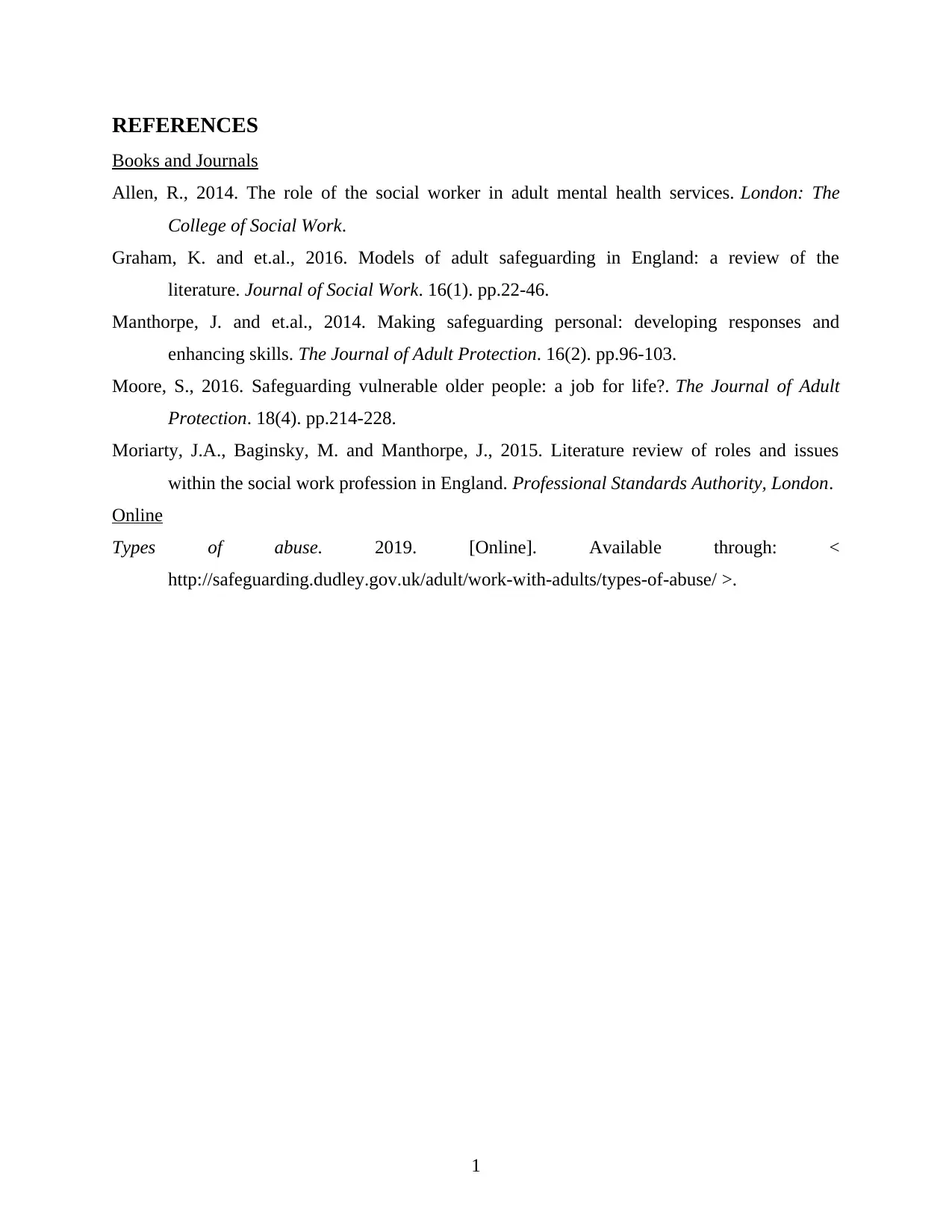
REFERENCES
Books and Journals
Allen, R., 2014. The role of the social worker in adult mental health services. London: The
College of Social Work.
Graham, K. and et.al., 2016. Models of adult safeguarding in England: a review of the
literature. Journal of Social Work. 16(1). pp.22-46.
Manthorpe, J. and et.al., 2014. Making safeguarding personal: developing responses and
enhancing skills. The Journal of Adult Protection. 16(2). pp.96-103.
Moore, S., 2016. Safeguarding vulnerable older people: a job for life?. The Journal of Adult
Protection. 18(4). pp.214-228.
Moriarty, J.A., Baginsky, M. and Manthorpe, J., 2015. Literature review of roles and issues
within the social work profession in England. Professional Standards Authority, London.
Online
Types of abuse. 2019. [Online]. Available through: <
http://safeguarding.dudley.gov.uk/adult/work-with-adults/types-of-abuse/ >.
1
Books and Journals
Allen, R., 2014. The role of the social worker in adult mental health services. London: The
College of Social Work.
Graham, K. and et.al., 2016. Models of adult safeguarding in England: a review of the
literature. Journal of Social Work. 16(1). pp.22-46.
Manthorpe, J. and et.al., 2014. Making safeguarding personal: developing responses and
enhancing skills. The Journal of Adult Protection. 16(2). pp.96-103.
Moore, S., 2016. Safeguarding vulnerable older people: a job for life?. The Journal of Adult
Protection. 18(4). pp.214-228.
Moriarty, J.A., Baginsky, M. and Manthorpe, J., 2015. Literature review of roles and issues
within the social work profession in England. Professional Standards Authority, London.
Online
Types of abuse. 2019. [Online]. Available through: <
http://safeguarding.dudley.gov.uk/adult/work-with-adults/types-of-abuse/ >.
1
1 out of 10
Related Documents
Your All-in-One AI-Powered Toolkit for Academic Success.
+13062052269
info@desklib.com
Available 24*7 on WhatsApp / Email
![[object Object]](/_next/static/media/star-bottom.7253800d.svg)
Unlock your academic potential
© 2024 | Zucol Services PVT LTD | All rights reserved.





